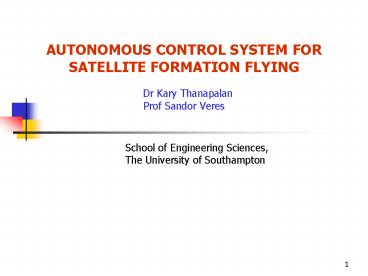AUTONOMOUS CONTROL SYSTEM FOR SATELLITE FORMATION FLYING - PowerPoint PPT Presentation
1 / 16
Title:
AUTONOMOUS CONTROL SYSTEM FOR SATELLITE FORMATION FLYING
Description:
Failure of a satellite = deterioration of the system, system performance, but ... (SFD) and thrusters, reaction wheels to execute feedback control in realtime ... – PowerPoint PPT presentation
Number of Views:146
Avg rating:3.0/5.0
Title: AUTONOMOUS CONTROL SYSTEM FOR SATELLITE FORMATION FLYING
1
AUTONOMOUS CONTROL SYSTEM FOR SATELLITE FORMATION
FLYING
- Dr Kary Thanapalan
- Prof Sandor Veres
- School of Engineering Sciences,
- The University of Southampton
2
Outline of the presentation
- Formation Flying Concept
- Agent Based Control System Design
- architecture
- high level control
- high level communications
- on board agents
- low level communications
- Our testing hardware
- Conclusions
3
Formation Flying Concept
- Idea Replace a large and unpractical satellite
by several small and inexpensive one. - Advantages
- Emulated system more flexible.
- Failure of a satellite gt deterioration of the
system, system performance, but does not
jeopardise the whole mission.
4
4
- Formation Flying Concept
novel concept pursued presently by numerous
research groups, including NASA and Air Force.
5
- Formation Flying Concept
Research Challenges
- Formation diameters quite small from several
dozens of meters to several kilometres
distances/angles between spacecrafts have to be
very accurate
- More satellites more collision avoidance
problems
- Reconfiguration and maintaining formation
fuel cost optimisation is needed for manoeuvres
and formations
- Controllers are needed which are efficient and
easy to implement on board.
6
Agent based control system design
- Cluster level agents
- Multi-agents on board of each craft
- High level communication with cluster level
agents, mission control and the local manager - (i.e. communication/coordinator (CC) agent, one
on board of each craft) - Low level communication between other on board
agents (messages with labelled data sets)
7
Multi Agent Architecture for the cluster
For the whole cluster
Cluster operations monitoring agent
Mission control (human)
Fleet formation planner agent
Thruster control agent
Maneuver Executor adaptive feedback controller
agent
Communication and Coordinator agent
Local path planner agent
Position and attitude data communicator
Sensor Data Fusion agent
Repeated on each satellite
8
High level control system
high level communications
For the whole cluster
Mission control (human)
Fleet formation planner agent
Communication and coordinator agents for each
satellite
Cluster operations monitoring agent
high level communication (one-way)
cluster
Sensor data fusion agents for each satellite
9
High level communications (SOL)
- Basic concepts defined in an ontology SOL
(satellite, thruster, formation, attitude, local
position, etc.) - The actual world of the cluster is instantiated
in terms of SOL for each participant. - Each of the Fleet Planner (FP), the Cluster
Monitor (CM) and the Communicator/Coordinator
(CC) and Sensor Data Fusion (SDF) agents on
board of each satellite have an interpreter that
examines the consequences for the internal state
of the agent. - Examples of sentences in the SOL language
- move_to_position(2.3,4.5,4.5)
- test_feasibility_of_formation(
Data_set_358) - satellite_attitude_error(Sat0
X01, 0.1,0.3,1)
10
Communication and coordination agent (CC) on
board of each craft
- Reactive agent
- Its state is determined by interpreted
communications from CC, SDF and Manoeuvre
Executor (ME) and Mission Control (MC) - Its behaviours are essentially sending low level
action messages to Local Path Planner (LPP) and
ME, depending on sets of conditions being
satisfied (it acts like a local manager). - Subsumption architecture sets priorities of the
commands to be issued by CC
11
Maneuver Executor (ME) adaptive feedback
controller
- Follows planned flight path and attitude by an
adaptive feedback control scheme - It heavily relies on fast rate communication with
the sensor data fusion agent (SFD) and thrusters,
reaction wheels to execute feedback control in
realtime - It can switch between control strategies upon
request from on board CC - Does not control collision avoidance but reports
malfunction (collision avoidance is ensured by
cluster level planner) - It only communicates at low level (labelled data
records)
12
Sensor Data Fusion (SFD) agent
- It is essentially an enhanced estimator for the
satellite position and attitude in the local and
inertia coordinate systems that also has the
ability to report sensor problems - It uses measurements obtained from sensor agents,
if any data does not arrive or is faulty it is
still able to come up with - For each sensor there is an agent process
(driver) running that is capable to monitor the
reliability of the sensor (solid state gyros,
stereo vision, star, Earth and Sun sensors) and
reports malfunction to SFD
13
Position and attitude data communicator (on each
craft)
- It sends to all other satellites its own position
and attitude - It receives from all other satellites their
positions and attitudes as it was one sampling
period earlier - This allows SFD to use the maximum amount of
shared information (for instance the stereo
images can be compared with what the viewed
satellites says about its attitude) - The position and attitude data of each satellite
is combined on board of each craft to produce the
highest possible precision of estimation for
realtime feedback control. Estimation is based on
a high dimensional Kalman filter. - Sampling rates are about 10Hz, so fast
communication is taking place between all
satellites.
14
Progress so far
- We are still working on increasing the ontology
vocabulary and sentences of (SOL) - We have designed the basic management
behaviours of the CC agents - We have coded the ME adaptive feedback control
agents - We are testing the SDF agent partly on real and
partly on simulated data. - The position and attitude data communicator
essentially complete - We have built a laboratory testing hardware
including 3 satellite models.
15
- Summary
- We are using a minimal complexity agent
architecture that does the job - Agents are important for functional modularity,
reliability and maintainability of software - Encapsulation of behaviour allows easier testing
and checking logical consistency of the whole
system, i.e. verification.
16
Thank you































